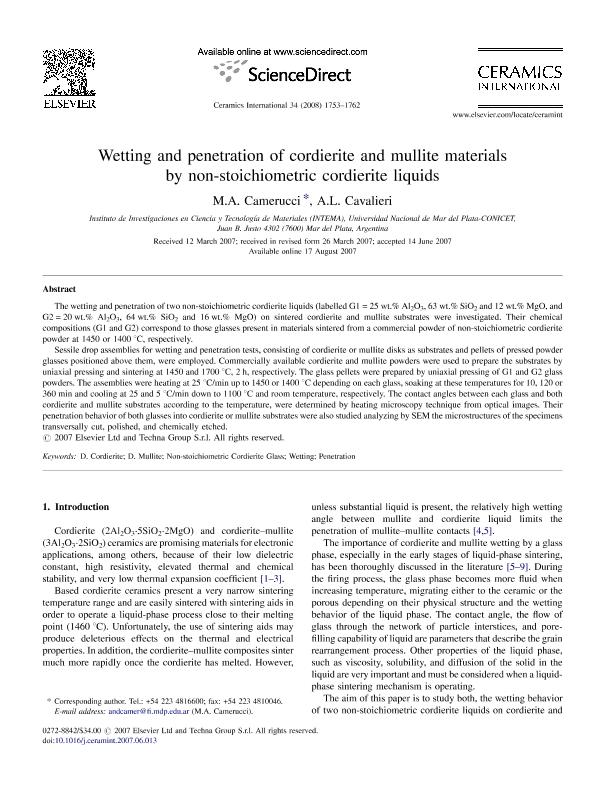Artículo
Wetting and penetration of cordierite and mullite materials by non-stoichiometric cordierite liquids
Fecha de publicación:
17/09/2008
Editorial:
Elsevier
Revista:
Ceramics International
ISSN:
0272-8842
Idioma:
Inglés
Tipo de recurso:
Artículo publicado
Clasificación temática:
Resumen
The wetting and penetration of two non-stoichiometric cordierite liquids (labelled G1 = 25 wt.% Al2O3, 63 wt.% SiO2 and 12 wt.% MgO, and G2 = 20 wt.% Al2O3, 64 wt.% SiO2 and 16 wt.% MgO) on sintered cordierite and mullite substrates were investigated. Their chemical compositions (G1 and G2) correspond to those glasses present in materials sintered from a commercial powder of non-stoichiometric cordierite powder at 1450 or 1400 °C, respectively. Sessile drop assemblies for wetting and penetration tests, consisting of cordierite or mullite disks as substrates and pellets of pressed powder glasses positioned above them, were employed. Commercially available cordierite and mullite powders were used to prepare the substrates by uniaxial pressing and sintering at 1450 and 1700 °C, 2 h, respectively. The glass pellets were prepared by uniaxial pressing of G1 and G2 glass powders. The assemblies were heating at 25 °C/min up to 1450 or 1400 °C depending on each glass, soaking at these temperatures for 10, 120 or 360 min and cooling at 25 and 5 °C/min down to 1100 °C and room temperature, respectively. The contact angles between each glass and both cordierite and mullite substrates according to the temperature, were determined by heating microscopy technique from optical images. Their penetration behavior of both glasses into cordierite or mullite substrates were also studied analyzing by SEM the microstructures of the specimens transversally cut, polished, and chemically etched. © 2007 Elsevier Ltd and Techna Group S.r.l.
Archivos asociados
Licencia
Identificadores
Colecciones
Articulos(INTEMA)
Articulos de INST.DE INV.EN CIENCIA Y TECNOL.MATERIALES (I)
Articulos de INST.DE INV.EN CIENCIA Y TECNOL.MATERIALES (I)
Citación
Camerucci, Maria Andrea; Cavalieri, Ana Lia; Wetting and penetration of cordierite and mullite materials by non-stoichiometric cordierite liquids; Elsevier; Ceramics International; 34; 7; 17-9-2008; 1753-1762
Compartir
Altmétricas




